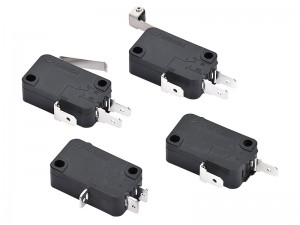Introduction
As the core component of circuit control, the terminal type of micro switch directly affects the installation efficiency, electrical performance and scene adaptability. With the growing demand for high density and high reliability in industrial automation and intelligent devices, terminal technology has become a key direction for micro switch innovation. This article combines industry standards and cutting-edge applications to systematically analyze the technical characteristics and selection logic of mainstream terminal types.
Terminal Types and Core Characteristics
Micro switch terminals can be divided into four categories according to the connection method: PCB terminals, Screw terminals, Quick-Connect Terminal, and Solder Lug. PCB Terminals can be soldered directly to circuit boards. It is compact and space-saving, suitable for high-density integrated design and miniaturized devices (e.g., smart watches, medical sensors), but it is not removable after soldering and has high maintenance costs. Usually used in consumer electronics, portable devices, the main control circuit connection. Screw Terminal crimps the wires by screws. It supports high currents, has strong anti-vibration performance and high reliability, with a protection level of up to IP67, and is suitable for high-vibration scenarios (e.g., construction machinery, rail transportation). However, installation is time-consuming and the tightness of the screws needs to be checked regularly. It is often used in industrial motor control, new energy charging pile power module. Quick-Connect Terminal adopts plug-and-play design to support quick installation and replacement, and the contact material is mostly silver-plated copper alloy, with a plug-and-play life of ≥500 times. Its maintenance is very convenient, suitable for frequent replacement scenarios (such as automated production line test equipment). However, the cost is high and the current carrying capacity is weak (usually ≤10A). It is often used in instruments, detachable industrial modules. Solder Lug use solder to fix the wires and it has strong compatibility, which is suitable for customized wiring, the contact resistance ≤ 50mΩ. It has highly flexibility and low cost, but the welding process requires high easy to cause poor contact due to cold welding.It is often used in home appliance control boards, low-power sensor circuits.


Selection and installation points
Selection Logic
When selecting terminal type, you need to consider three main aspects: current and voltage, environmental adaptability, and maintenance requirements. Screw terminals are preferred for high-current scenarios (>10A) and PCB terminals for low-current signaling (<1A). Humid environments require IP67 connector terminals; high-temperature scenarios (> 85 ℃) recommended gold-plated or silver alloy contacts. Connector terminals are suitable for frequent debugging equipment; solder or screw terminals are recommended for fixed installation equipment.
Installation points
Installation of screw terminals need to use a torque screwdriver to control the tightening force (usually 0.5-0.8N-m), and add a spring washer to prevent loosening. PCB terminals using reflow soldering process, you need to avoid soldering, the layout of the layout of the space reserved for heat dissipation, to prevent the temperature rise affect the performance of the contacts. When installing the connector terminals need to ensure that the insertion and connection direction is correct, avoid lateral force when inserting and extracting, in order to prevent pin deformation.
Industry applications and innovation trends
Various types of terminals are now mainly used in industrial automation, smart homes, new energy vehicles and other industries. Honeywell V15 series adopts screw terminals, supports 15A current, is used for robotic arm limit switches, and is resistant to 50G vibration shock. Omron D2F series PCB terminal switches, with a thickness of only 2.5mm, are integrated into smart door lock control boards for low-power signal transmission. Waterproof connector terminals (IP69K) are used in battery management systems to realize fast plugging and fault isolation of high-voltage circuits.
Technology Trends
In terms of technological innovation, there is a trend toward intelligence as well as environmental protection. Intelligent research and development is constantly being carried out, and terminals with integrated pressure sensors can monitor the contact status in real time and warn of potential failures (e.g., the Tesla Optimus robot joint module). Continuous introduction of environmentally friendly materials, lead-free solder and biobased plastic enclosures are gradually popularized to meet the EU RoHS 3.0 and carbon neutrality targets.
Conclusion
From milliamp signal to kiloamp power, the technological evolution of microswitch terminal types demonstrates the deep coupling of electronic component design and scenario requirements. In the future, with the advancement of intelligent manufacturing, terminal technology will become more modular and adaptive, injecting new momentum into the global industrial chain.
Post time: Apr-10-2025






